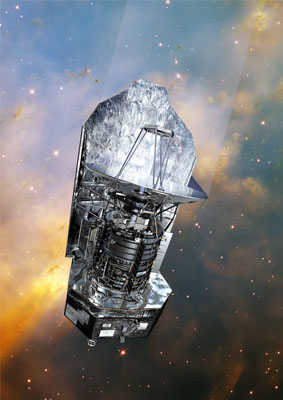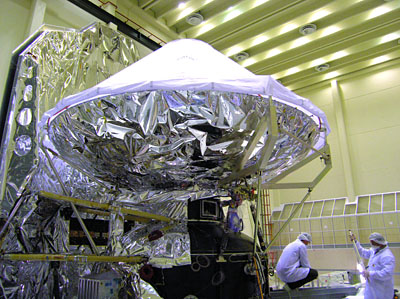The construction of the Herschel Space Telescope has been completed for all its components, in the coming weeks the spacecraft will undergo a series of mechanical tests

The European Space Agency has announced the completion of the construction of the future space telescope for deep space exploration. The current phase is a milestone, after the engineers finished assembling the telescope's mirror, the sun shield, the solar panels and the supporting components on top of the spacecraft's service module, they actually finished assembling the spacecraft. In the coming weeks, the spacecraft will undergo several final tests.
The infrared telescope contains a mirror with a diameter of 3.5 meters. The mirror is a technological marvel, it is lightweight, built from complex materials and the most advanced techniques.
The main mirror, the secondary mirror, and the supporting structure of the telescope, all together weigh only 320 kg. An impressive achievement in itself compared to the capabilities of the telescope and compared to the weight of other similar devices.
Herschel will help scientists look deep into space at long infrared wavelengths. The telescope is named after the British astronomer William Herschel who discovered infrared radiation.

The use of infrared wavelengths will complete a broader picture for cosmologists. Whether we are talking about bodies in the near galactic environment or whether we are talking about observations anywhere else in the universe, using infrared radiation will locate more and less "hot" areas. Areas that apparently contain nothing in visible light, can hide various bodies that Herschel will "see". The purpose of an infrared space telescope is to teach us things that a normal optical telescope cannot teach.
According to the plan, the telescope will go into space during 2008. Its life span is at least 3 years. The mission will come to an end when the helium used to cool the scientific instruments runs out.

8 תגובות
A. Ben-Nur, you are confusing the "International Space Station". And I meant "space shuttles". In 2010, the International Space Station should be completed, and then the space shuttle fleet (Discovery, Endeavour, and Atlantis) will be retired. NASA is working on a new model of spacecraft in "Project Orion".
Since in the past the shuttles performed repair tasks in space, such as repairing the Hubble Space Telescope, there is a fear that after the retirement of the space shuttles they will stop the repair/refueling tasks in space.
The Herschel engineers took this into account, if they do not repair/refuel the telescope in the future then its lifespan will be limited. Otherwise, it will be possible to extend the lifespan of the telescope in a few years.
To Rami Yushobiev, your question is over.
A]. Which ferry do you mean? Is this the international one whose construction has not yet been completed? Does it end in 2010?
So it's even more puzzling, something doesn't add up here. and besides that..
B]. The "Hubble" (and other space telescopes) has been refrigerated for about a decade,
More or less, so what's the difference here?
third]. I have an intuitive feeling, a little skeptical and a little evil, about European projects. It seems to me like today's Tower of Babel, which is being built by people of seventy languages who not only do not properly understand each other, but also compete among themselves as to who will be considered number one in success.
And what language do they speak there? English?
For the French it is a national disaster, after all England is not in Europe at all. And the Germans only know German. in brief -
May God have mercy.
In my opinion, football is much more suitable for them,
Because in football you don't have to cooperate but fight (sportingly of course and for the time being...) with each other.
The telescope should work for several years, the "minimum" period is 3 years. There are also plans to carry out resuscitation operations like they did for the Hubble Space Telescope, but since the shuttle will be decommissioned in 2010, it is assumed that this will be done with the help of American spacecraft of the Orion program. Since there is no certainty, in the press release they wrote "minimum" 3 years.
Who has the strength to go up there to refuel?
It's a piece of history.
and issue a standard for it
And binders and binders and correctness
A complete tirade and even if you did all of this, suddenly the committee strikes you
What is the problem with filling it with liquefied gas for cooling with a new container.
At worst return it and refill.
An economic question
Build a technological marvel and put it on track.
After 3 years it is no longer effective and then it either continues to hang around us at ease or it burns up in the atmosphere.
Isn't it financially better to "refuel" it after a period?
In this case helium, but in other cases fuel for engines for runway corrections.
Or in advance it is assumed that after 3 years it will already be outdated and broken.
I asked Rami how many astronauts are leaving the space station today
We know how Herschel's stories end